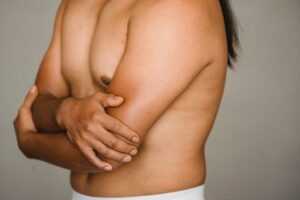Published by Dr MIguel Fernadez Calderón: 30/11/2023
The gynecomastia in men is a condition that affects them in large numbers, it is more common than you think. It is characterized by the increase of breast tissue in males. Keep reading! We explain what it is, the causes and treatments.
What is Gynecomastia in men?
Gynecomastia is a condition that appears exclusively in boys and men, and involves the formation and accumulation of breast tissue in the chest area..
Gynecomastia can affect one breast or both, sometimes unevenly.
Although it can cause pain, in most cases gynecomastia is not a serious problem, but for those who suffer from it, it can be difficult to deal with this condition. They may even feel embarrassed, so it is best to opt for surgery to correct it.
Differences between gynecomastia and pseudogynecomastia
We often refer to the accumulation of fat alone as gynecomastia, but the truth is that breast tissue must be present to diagnose this condition.
In the case that only fat accumulation occurs in the chest, we would be talking about pseudogynecomastia. However, it is very common to see cases in which both gynecomastia and pseudogynecomastia occur in the male chest.
Even if we lose weight, we may still have excess glandular tissue, which causes even very thin men to notice enlarged breasts. even very thin men notice enlarged and unattractive breasts. and unattractive.
Common Causes of Gynecomastia
The causes of gynecomastia are, in the vast majority of cases, unknown at the clinical level. This is because it can occur for various reasons, among which are hormonal changes and the intake of certain medications.
As for hormonal changes, gynecomastia may appear when the amount of testosterone drops compared to estrogen.
On the other hand, medications that can cause gynecomastia include: antiandrogens, anabolic steroids, antiretroviral drugs, ADHD medications containing amphetamines, anxiety medications, antidepressants, some antibiotics, chemotherapies, among others.
It is also believed that recreational and illegal drugs and alcohol may contribute to the formation of gynecomastia.
Certain health conditions can also affect hormonal balance and cause or be associated with gynecomastia, including aging, tumors, thyroid problems, kidney or liver failure, malnutrition, among others.
At different stages
Gynecomastia can occur at all stages of a man's life, although it tends to be more common in adolescence due to the different hormonal changes that can occur at this stage.
- Infant gynecomastia: More than half of all male babies are born with enlarged breasts because their mothers' estrogen levels are elevated. The swelling of the breast tissue usually disappears within two to three weeks after birth.
- Gynecomastia at pubertyHormonal changes during puberty can cause gynecomastia. Most of the time, the swollen breast tissue goes away on its own within six months to two to three years.
- Gynecomastia in adulthood: This type of gynecomastia usually appears due to the intake of certain medications or hormonal changes due to some disease. However, at this age fat accumulation (pseudogynecomastia) is more common.
In the case of pseudogynecomastia, the most common cause is a sudden change in weight, in which, even after having lost weight, there is still a deposit of localized fat that is difficult to eliminate with diet and exercise.
Main risk factors
Puberty, aging, obesity, use of anabolic steroids and certain health conditions just mentioned can be risk factors for gynecomastia.
Symptoms of gynecomastia in men
Symptoms of gynecomastia can be:
- Pain, especially in adolescents.
- Swollen breast tissue.
- Sensitive breasts.
- Sensitive nipples, especially when rubbing against clothing.
We recommend that you see your doctor if you feel swelling, pain or tenderness, if you have fluid coming from one or both nipples, if you feel a lump, or if you notice dimpling of the breast skin.
Diagnosis of gynecomastia
The diagnosis of gynecomastia seeks to detect in men the presence of sub areolar breast tissue, and some other signs such as nipple retraction, small holes in the skin or some type of discharge.
Clinical evaluation
The main method used by physicians to detect gynecomastia is a physical examination, through which they can palpate the presence of glandular tissue of two centimeters or more in diameter. In addition to this, the specialist can resort to other methods and tests to complete the evaluation.
Recommended diagnostic tests
- Blood tests: are performed in order to know the values of hormones such as estrogen, testosterone, hCG, LH and FSH. Hormonal alterations may be indicative of an underlying disease of which gynecomastia is a side effect.
- Liver function tests: some pathologies associated with the kidney can cause increased breast tissue in men. Therefore, knowing how the patient's liver and/or kidney function is can help the physician in the diagnosis.
- A mammogram or ultrasound may be used to rule out the presence of other types of tissue, abscesses or boils.
- Biopsies or tissue samples: these tests are used to remove tissue from the breast area and analyze it for cancer or tumors.
After all these tests, the doctor can determine if the patient has a real gynecomastia, and will be able to indicate the treatment or if it will be necessary to resort to surgery.
How can we solve gynecomastia?
The will vary depending on whether the patient has actual gynecomastia, only pseudogynecomastia (fat accumulation), or both.. In the first case, we would opt for a mastectomy, in the second for liposuction and in the third case we could combine both processes in order to achieve the best result.
Male breast reduction through mastectomy is currently the only effective treatment for gynecomastia, as it offers a long-lasting, if not permanent, solution. offers a long-lasting, if not permanent, solution. After this surgery, patients usually feel comfortable, as they can take off their shirts without complexes and report having gained greater self-confidence.
If we feel uncomfortable with the appearance of our breasts, or if we end up avoiding certain activities for fear of showing them, treatment to eliminate gynecomastia and pseudogynecomastia is an excellent option to consider to make our complexes disappear once and for all. to make our complexes disappear once and for all.
With the help of an experienced cosmetic surgeon, with the help of an experienced cosmetic surgeon, the procedure can offer dramatic and almost immediate improvements.. At Sculpture Clinic we specialize in all types of breast and body surgery, always trying to find the perfect solution for you.
Gynecomastia with tissue removal (mastectomy)
Severe cases of gynecomastia may require surgical removal of tissue to achieve optimal results.. Patients who have loose, wrinkled, sagging skin around the breasts may also need this treatment. This allows the surgeon to remove more glandular tissue than would be possible with liposuction alone.
The location and length of the incisions depend on the extent of the surgery. However, are usually made around the edge of the nipple (periareolar), or within the natural crease of the breast. A skilled and qualified plastic surgeon should be responsible for making the incisions so that they are as inconspicuous and hidden as possible.
Gynecomastia with liposuction
Today, cosmetic surgeons are able to treat an increasing number of patients with pseudogynecomastia using liposuction. This is due to advances in this technology, which have led to increasingly less invasive and safer have resulted in increasingly less invasive and safer procedures..
However, the skill and experience of the surgeon also play an important role.and the choice of a breast surgeon who has training in liposuction and experience in the removal of gynecomastia and pseudogynecomastia is essential.
The usual treatment is usually performed under local anesthesia with sedation or general anesthesia.and consists of a small surgical incision on both sides of the chest. Depending on the patient's needs, the surgeon may prefer one type of incision over another.
Through these incisions, the surgeon removes excess fat, while sculpting a natural-looking breast contour to the body.while sculpting a breast contour that looks natural to the body.

Postoperative Recovery Process
The recovery process varies depending on the type of surgery performed, whether it is liposuction or mastectomy.
In general, major discomfort lasts a few days, discomfort and tenderness disappear within a week or two, and you can probably return to work within 15 days.
Avoid heavy lifting during recovery, raising your arms above your head for the first few weeks and always follow the surgeon's recommendations.
In both cases, it is essential to understand that each person heals at his or her own pace. Therefore, we will try to give our patients an individualized recovery period. As well as specific recommendations for their recovery.
Postoperative mastectomy
The recovery process is similar to that of liposuction; however, it is not uncommon for patients to experience pain, some swelling and bruising. In any case, these discomforts are usually well controlled with an analgesic.
You will have bandages and a compression garment around your body while you heal. This will help reduce swelling. You will be prescribed medication for pain relief.
After surgery, patients must rest before returning to work, which can be anywhere from one to two weeks. A gradual return to exercise is usually allowed after three weeks to one month.
Postoperative liposuction
After liposuction, the recovery process is usually quite comfortable.. After surgery, patients usually wear a compression garment to help minimize swelling and provide some support to the healing tissues for the first few weeks.
Exercise is usually prohibited for about three weeksbut many patients return to work within a few days of undergoing the procedure.
You may have tubes to drain fluids and blood after surgery, which will tell you when they will be removed.
Keep in mind that you will not see the results in the first few days, you will have to wait three to six months after surgery. This is because the breast tissue takes time to heal and you must wait for all the swelling to disappear.
Advantages of gynecomastia surgery
hose who undergo this surgery feel much more self-confident and feel more comfortable with their appearance. They will be able to take off their shirts when going to the pool or the beach without fear.
In addition, that excess tissue can cause discomfort and even pain that, when the surgery is performed, will no longer be a problem. They will be able to jump, run and do activities they used to avoid.
Psychological impact and support for patients with gynecomastia
Those diagnosed with gynecomastia, in addition to suffering from the physical condition, often have problems of self-esteem, anxiety and may feel very embarrassed. In some more complex cases, the patient may suffer from depression and embarrassment to show themselves in public, even to the point of isolating themselves from their environment.
Men whose breasts are very large may be bullied, which makes them feel rejected in family situations, in educational spaces or even at work.
They also look for ways to hide their condition by hiding in their clothes, although it is often difficult for them to find clothes that fit well and make them feel comfortable. For others, gynecomastia can also affect their sex life, as they do not feel good about their body or the way they look.
Addressing the emotional impact and support options
Because gynecomastia can affect the patient psychologically, seeing a mental health specialist can be an effective solution so that you can deal with the feelings this condition causes you. A therapist can also teach coping mechanisms to deal with negative thoughts and deal with the stress and anxiety you may feel when looking in the mirror or being in front of other people.
Looking for support groups is another way to help these patients, since they can share experiences and experiences with people going through a similar situation. In this group it is possible to exchange ideas, advice and learn from what others have achieved.
Gynecomastia Operation for Men in Madrid Spain
In conclusion, at Sculpture Clinic you will find all the necessary information for a gynecomastia surgery for men in Madrid Spain.. We will perform a detailed study of your case and solve all your doubts. Finally, we will give you a quote tailored to your needs.









